The Autumnal woodlands of the North Eastern States are adorned with nature’s enchantments. As temperatures cool, dark green leaves fade to yellow, while the sugary maple bleeds scarlet into the canopy’s canvas.
A gentle breeze through the sun dappled foliage sent light fairies dancing across the leafy carpet. The woodland-wide web of mycelium hummed with the chatter of trees, as it pushed its mushroomy masts through the damp substrate.

I visited the forest to search for nuggets of gold that appear from under the Fall carpet. A brilliance of orange that looks out of place, even in this wooded wonderland.
My eyes worked methodically across the forest floor. I knew that I was looking for a needle in a haystack, but when that needle fluoresces like a twinkling ember in charcoal, it gives hope that the needle may catch even these old eyes.

The hot orange of fallen leaves caught the eye first, but gradually the brain filtered them out of the hunt for a fleck of fire. A patch of brown leaves had hatched to reveal a delight of Chanterelles. This aromatic spray of peppered apricot is a gift from the land, but on this day my search was for a far less palatable offering.
Decorating the decaying logs of long fallen giant, were tiny globules of golden wax that grabbed at the eye and made the heart skip. The excitement dwindled, as I realised that it was not the orange that I was seeking, but a just a few droplets of Witches Butter.
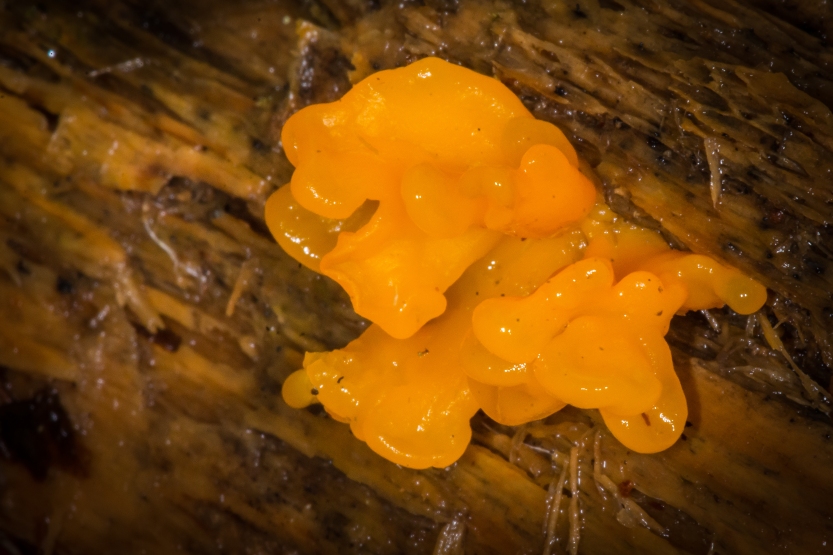
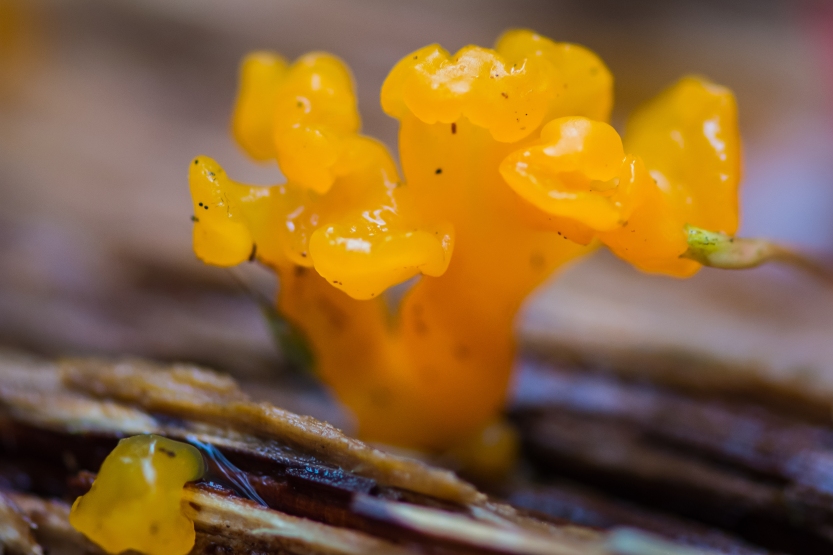
I lifted logs, scraps of fallen bark and rocks. The damp earth under the decaying wood gave life to a host of critters. slugs, worms, crickets, centipedes, millipedes and the sentient eyes of tiny salamanders. I was excited by each and every salamander that I found, and made time to photograph them. But the search for my enchanted ember went on.
I headed to a small clearing by a stream and lifted some large logs, without success. I spotted a small piece of broken branch wresting on a bed of moss. I walked over to it and flipped it and my heart skipped over with it. There it was, my enchanted ember, my red eft!
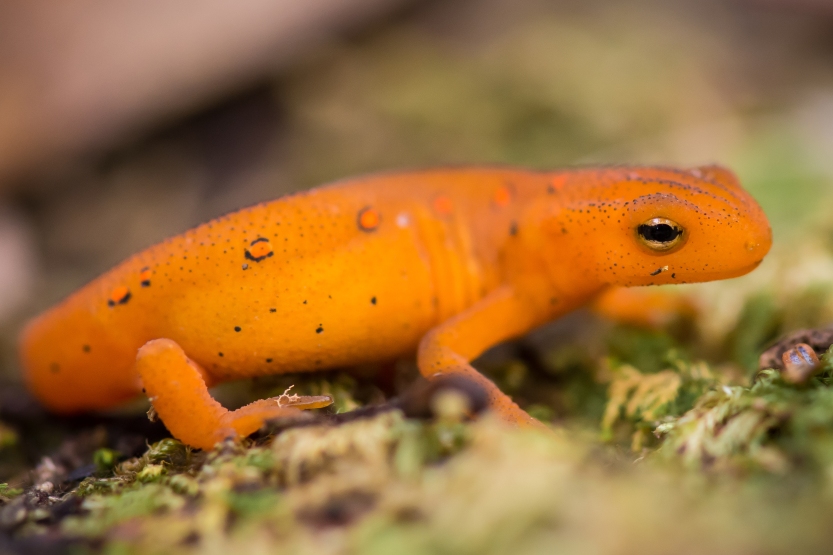
Like a tiny wingless dragon, the red eft glows as if fire burns inside it. It is tattooed with two rows of black rimmed tangerine spots running down the length of its back. It is not immediately obvious that this is a living creature created by nature, rather than the work of a fantasy fine art studio. The eft is impossibly beautiful!
The eft did not appear to be at all disturbed, so I was able to lie down and take some shots. Efts come in a variety of shades of orange, but this one seemed to be particularly fluorescent. I could have stayed with it all day, but I reluctantly returned its branch and with appetite whetted, I set off in search of more eft opportunities.
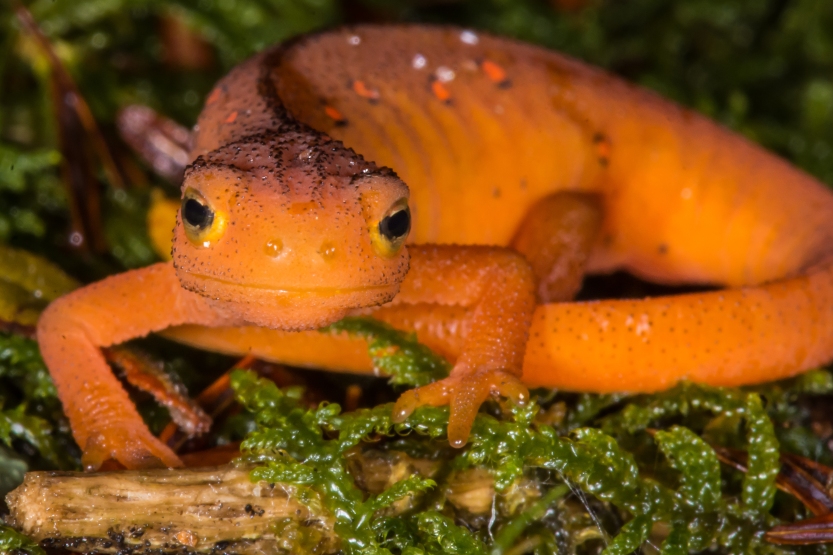
The red eft is not actually the species name for this precious little critter. It is the descriptor for the juvenile terrestrial phase of the Eastern newt. In its adult form the Eastern newt is brown, although it maintains the tangerine spots of the eft, throughout its life.
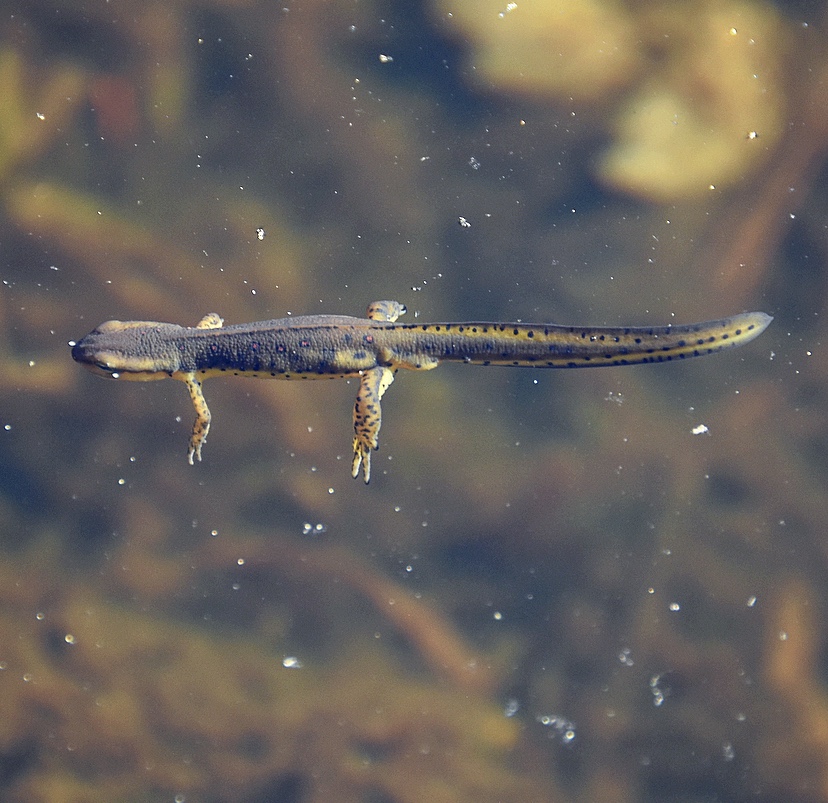

Born in water, the newt tadpole becomes the red eft as it losses its gills and crawls out on to dry land. When it finally returns to the water up to 5 years later, it remains fully aquatic for the rest of its life, although it still needs to surface for a breath of air.
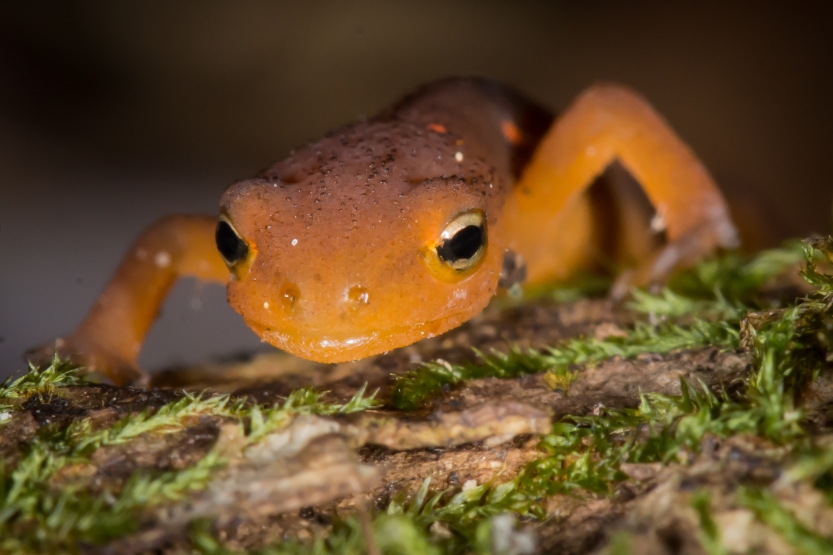
During this terrestrial phase of the red eft’s life, it packs a powerful punch. Its brilliant skin contains a nerve toxin called tetrodotoxin, that makes it a dangerous dinner date. The poison has been known to cause severe discomfort, paralysis and even death in predators, such as snakes, that attempt to devour them.
The weather turned from bright sunshine to torrential rain overnight. With the rain came a drop in temperature that saw the banks of the streams empty of their resident Green frogs. A little rain was not enough to keep me from walking the woodlands, but would the temperature drop affect the newts? The answer was a resounding no; the rain brought the red efts out in numbers.
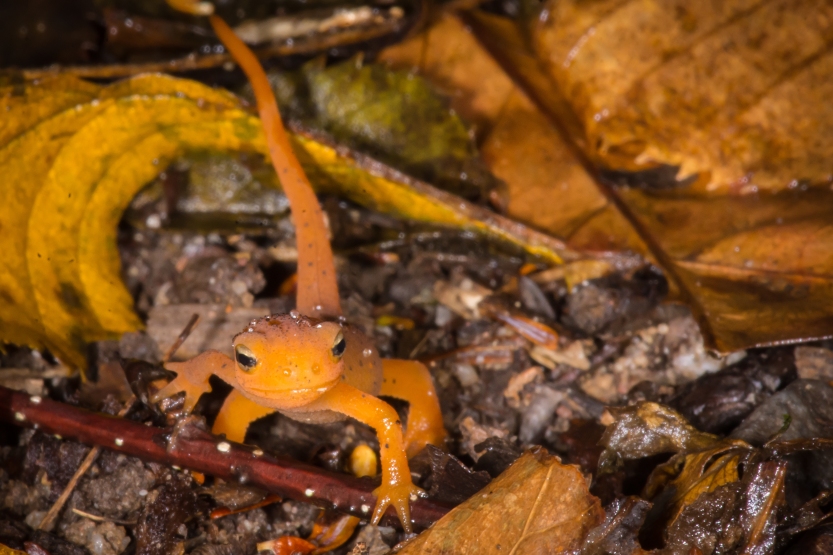
I walked carefully over the paint spill of wet leaves to flip over yet another log. There was nothing under the log, but as I returned it to its position, my eye was caught. Walking out in the open over the wet leaves was a red eft. That flutter of excitement struck again and as it did I noticed a second eft close by. A few seconds later I spotted a third; the rain had brought the efts out in numbers in broad daylight. Perhaps it is a self awareness of their deadly skin that gives them the confidence to walk out in the open when other creatures remain hidden.
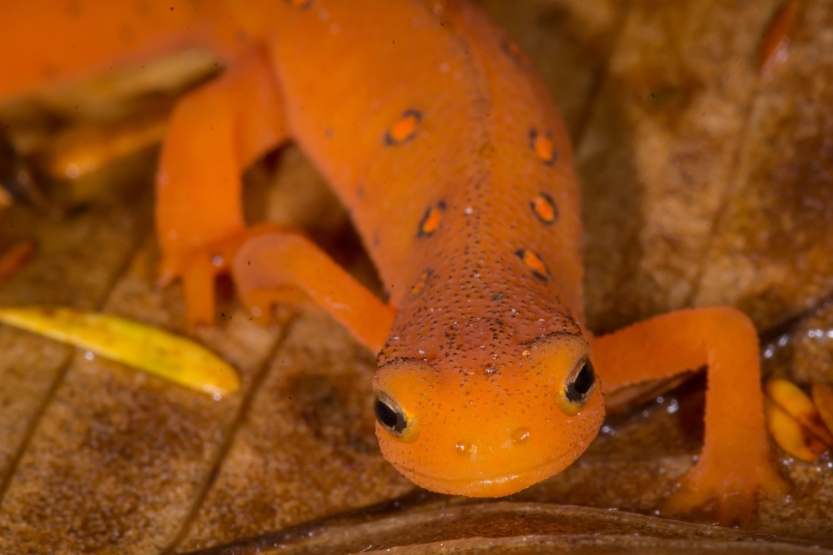
I kneeled down on the wet forest floor and started taking photographs. Before long I was laying down to get macro shots of those eyes and that engaging smile. I was getting soaked, but it was worth it to these extraordinary beings at eye level.
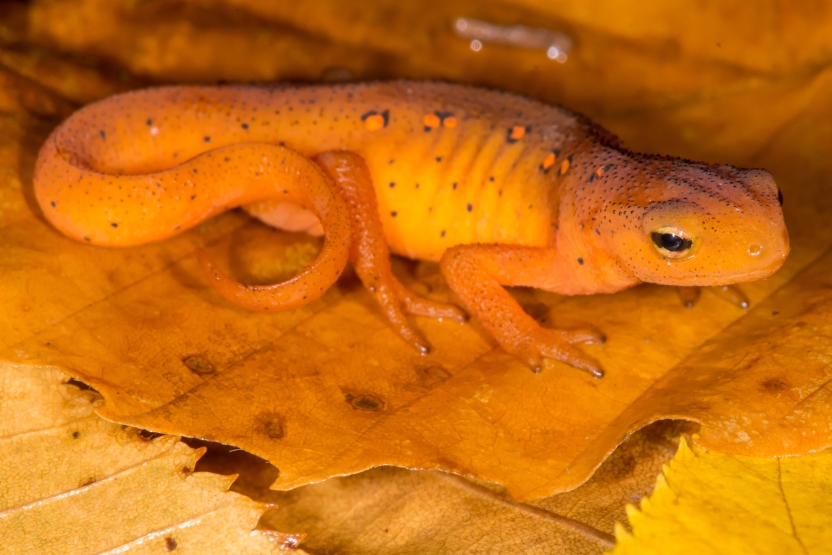
I photographed over a dozen efts in different parts of the forest, on various substrates. As I watched the little newt stride confidently over the fallen leaves it occurred to me how remarkable it was that such a vibrant skin could blend and vanish against the autumn colours. Perhaps the unlikely camouflage of the skin is as much a reason for the red efts daylight confidence as the poison packed beneath it.
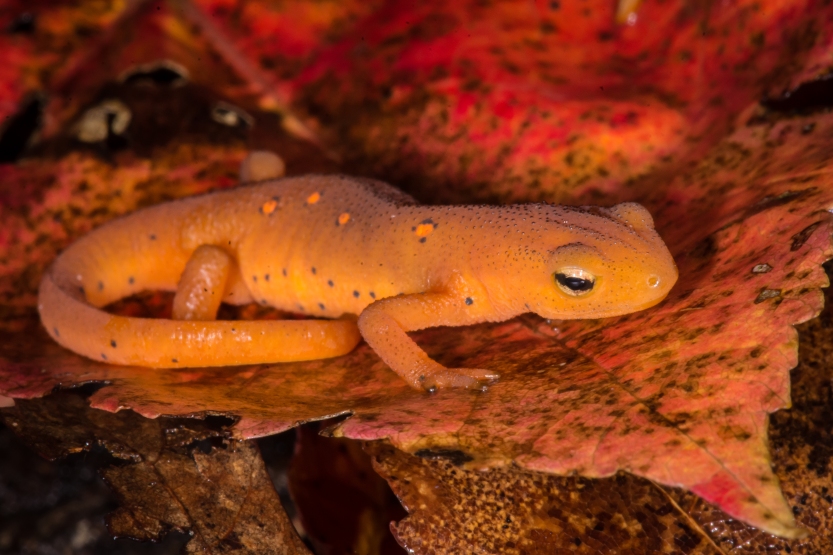
Reflecting on my time with the red efts, I place it high on the list of my favourite wildlife encounters. A finger-length orange newt right up there with spotting Bengal tigers, Orangutans, Grizzly bears and Komodo dragons. Yet I watched dog walkers, hikers and picnickers striding by, oblivious to the presence of these tiny trinkets. It reminds me that a deep connection with nature has been lost to us over the centuries.
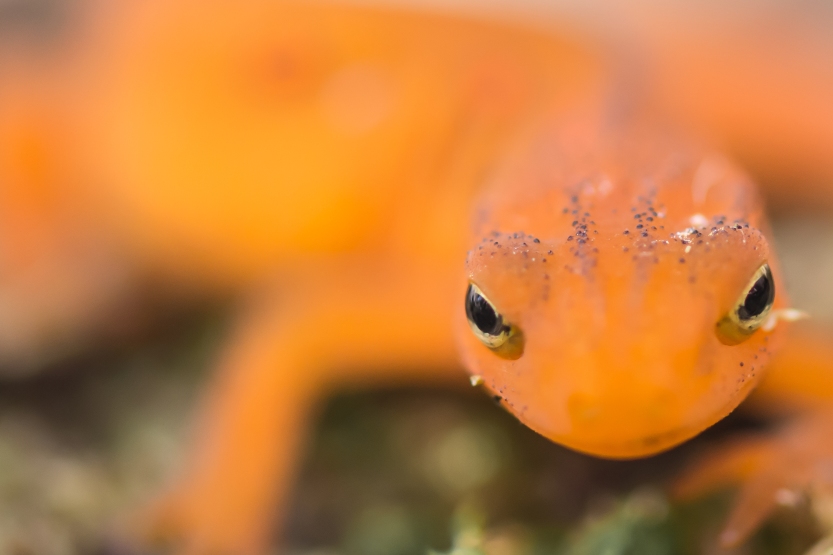
There is something of lore, of witchyness and wizardry about this little woodland amphibian. It is a creature with everything; unbelievable beauty, deadly poison and an aura of sorcery. For me, it is a thing of joy that nature hides in the forest for those who seek.
Join the conversation below. Have you seen a red eft? 👇👇👇
** Like the article? Share it! Consider following Incidental Naturalist. If you don’t have a WordPress account you can follow via email. No sales, nothing to sell, no spam **
Categories: Uncategorized, USA
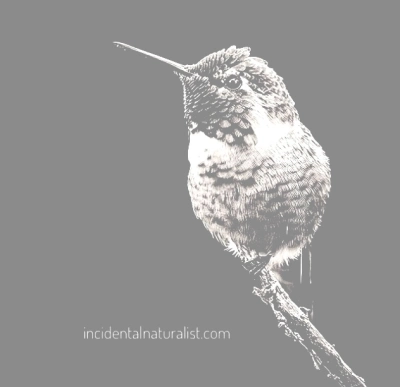




Reading this article was an excellent start to my day. Thank you. You write eloquently. What a special little creature!
LikeLiked by 1 person
Thank you, Cheryl! You are very kind. I’m really pleased that you enjoyed it. It certainly is a unique little critter.
LikeLike
I don’t think we have them in England, so it was a treat to see these. The benevolent expressions belie their poison.
LikeLiked by 1 person
We definitely don’t have these guys in Britain. We only have 3 newts which are all beautiful in their own way, but nothing that compares to this nugget.
LikeLike
That is an amazing creature! I was struck by the idea of the red eft being poisonous to animals that try to eat it, and I wondered how that could be a deterrent. Once the eft has been eaten, I presume that it is dead along with the snake or whatever ate it, so there is no way to pass on the knowledge and warning to other predators, and it doesn’t help the eft once he’s dead.
Beautiful little creature though.
LikeLiked by 1 person
I had the same thought so did a little research a while ago. Death can and does occur, but more often than not the predator will spit out the newt (often unharmed) and go into paralysis for up to an hour. A state of distress that is not so easily forgotten!
LikeLiked by 1 person
That makes more sense to me. Thanks for checking that out.
LikeLiked by 1 person
Even if predator kills THAT eft. After getting that sick, the predator will have 2nd thoughts of going after another. So the experience helps the other efts. For that matter it helps all critters with such bright colorings, and a whole system of brightly colored and poisonous critters (and bright colored and non poisonous cheaters) has evolved over millions of years.
See Mullerian and Batesian mimicry
https://en.wikipedia.org/wiki/M%C3%BCllerian_mimicry
It amazes me that a whole system of predator nervous systems (mostly vertebrate?) and prey developemental biology systems (in multiple clades) have cooperatively worked this system of red-orange-yellow/black coloring over what must be 10s of millions of years!
LikeLiked by 2 people
Hi Barry, it is amazing isn’t it? The system works, but there is always a disrupter somewhere that manages to tolerate the poison. The Monarch vs Viceroy is really interesting because the viceroy itself seems to be unpleasant eating, but not quite to bad as the Monarch. We even see nature creating body doubles like the ant mimicking spiders. I think I will be long dead before humans understand how life on earth works. Thanks for your insights! David.
LikeLiked by 1 person
Never seen one but certainly would be delighted to run across such a beautiful creature. Thanks for sharing.
LikeLiked by 1 person
Hearty congratulations on a most successful photo hunt. What a magnificent result.
LikeLiked by 1 person
Thank you very much! I had fantastic models.
LikeLiked by 1 person
Oh I am smitten! I’ve heard of efts, but never truly understood what they were, let alone that they come in such glorious colours. Your photographs are superb, and your words just exactly right to draw me in.
Lovely.
Alison
LikeLiked by 1 person
Thank you Alison! Very kind indeed. What a wonderful, magical little creature it is. 🧡
LikeLiked by 1 person
David “) thank you so much for your magical writing, shared experience, knowledge, and lush looking photos! I do feel a happy, healthy transport when reading your posts – don’t we all need that? Happy New Year =)
LikeLiked by 1 person
Happy New Year, Lara! Thank you, it is great to know that my post adds a little sunshine into your life for a few moments. ☺️
LikeLiked by 1 person
It so does =)! I shared your blog post on the Red Eft on FB. Hope some friends will enjoy reading as much as I did = p
LikeLiked by 1 person
What a beautiful creature! The whole post had an orange theme to it too 😀
LikeLiked by 1 person
The whole woodland seemed to have an orange theme! 😃 Just for a few weeks, until orange turns to brown and everything goes to sleep until spring.
LikeLike